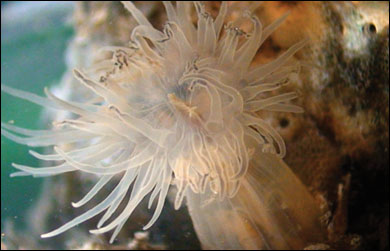Can It Help
Clean The Bay?
Waving graceful tentacles, this anemone occupies a nook of an artificial reef, only one of hundreds of inhabitants there. Photograph by Adam Frederick.
Contents
The Other Filter Feeders:
Mussels, Clams, & More
Sampling Life at the
Bottom of the Bay
Clear Water through Clam Culture?
Performance Honors
Rachel Carson's Life & Work

We mourn the loss of the Bay's oysters, of their ecological prowess and of the way of life they made possible. We mourn the loss of the Bay's great fisheries, of 100-lb sturgeon that once cruised these waters and shad that migrated up the Bay by the millions.
We don't mourn the less charismatic creatures — the sea squirts, worms, mussels, and clams. The other filter feeders that lived in the crevices of oyster reefs and the bottom-dwellers that lived in soft sediment, they too have declined in diversity and abundance, along with the health of the Bay. But we don't miss them like we miss the oysters.
The oysters went noisily, amidst conflict and gunfire. Their loss was felt with deep regret. One waterman reflected in the late 19th century, "If I had a chance to live my life over again, I guess it would be out on the water with the gulls when the sun come up on a boat, wheeling, and whipping around for another pass across a bed where the oysters used to come up as big as a man's hand."*
The others, those creatures of the benthos, were the civilian casualties of the oyster wars, of urbanization and pollution. They left quietly, their absence as inconspicuous as their presence. We don't even know exactly what species once thrived in great abundance. We've only been keeping tabs recently, our records reflecting times of scarcity, not of bounty.
During a recent visit to the National Museum of Natural History, I was struck by a diorama showing the creatures of the Burgess Shale as they might have looked living in ancient seas. The display showcased a living reef structure, reconstructed from fossils found in the Canadian Rockies in the early 1900s. Every nook and cranny was filled with life, the bottom of the ocean carpeted by ancient starfish-like crinoids and wriggling with crustaceans.
Did the Bay's oyster reefs once look like this? While historical reconstructions and maps of oyster reefs in the Chesapeake offer clues to the shape and extent of these structures, we know comparatively little about those animals that lived among the oysters and those that thrived in and on the bottom of the Bay.
We've lost more than we ever knew we had. We'll never know for sure what role these other species played in the ecology of the Bay of the past, how they may have helped to keep the waters clear. Today's Chesapeake is a changed place — a product of human engineering, intended or otherwise. The Bay's ecology has been sculpted by years of harvest, use, and often abuse.
The Bay of the future will also be shaped by acts of engineering, its ecological state reflecting choices that we make to restore or deplete aquatic resources and to develop or conserve surrounding land. We're trying as hard as we can to bring back the native oyster, and we're even considering introducing a non-native one. We're trying to spawn the great ancient sturgeon, hoping to restock the rivers with young fish raised in hatcheries. But we rarely think about mussels, sea squirts, clams, and worms. We keep some track of their comings and goings through surveys, but they've largely fallen to the sidelines of any active restoration plans.
If our goal for the Chesapeake is cleaner waters and healthier fisheries, perhaps these less glamorous animals could lend a hand, assisting oysters with the monumental task of filtering the Bay's murky water. For the Chesapeake's one species of oyster, there are dozens of other species — mussels, clams, and more — each equipped with a similar strategy for feeding, one that removes algae from the water column. Perhaps the oyster will always reign supreme among filter feeders. But aren't the others worth a closer look?






![[Maryland Sea Grant]](/GIFs/h_footer_mdsg.gif)